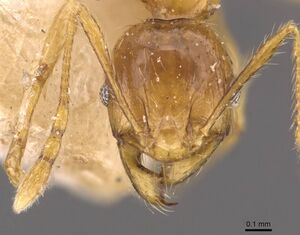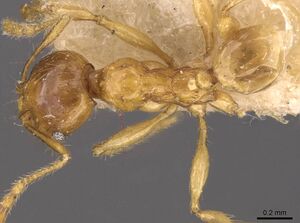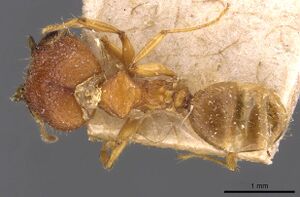Pheidole upeneci
| Pheidole upeneci | |
|---|---|

| |
| Scientific classification | |
| Kingdom: | Animalia |
| Phylum: | Arthropoda |
| Class: | Insecta |
| Order: | Hymenoptera |
| Family: | Formicidae |
| Subfamily: | Myrmicinae |
| Tribe: | Attini |
| Genus: | Pheidole |
| Species: | P. upeneci |
| Binomial name | |
| Pheidole upeneci Forel, 1913 | |
This species seems to inhabit well-developed hill forests.
Identification
Eguchi (2001a) - The type material from Java is somewhat different from Bornean specimens: in the former frontal lobe of the major almost horizontal; occipital lobe of the major in profile more rounded posteriorly; posterior declivity of promesonotal dome with an inconspicuous prominence in both the subcastes; petiole smaller in both the subcastes (postpetiole ca. 2.0 times as broad as petiolar node) (see also Eguchi, 2001). This suggests the possibility of the presence of local populations defined by a series of morphological characteristics.
Keys including this Species
- Key to Pheidole majors and minors of Borneo
- Key to Pheidole majors of Borneo
- Key to Pheidole minors of Borneo
Distribution
Latitudinal Distribution Pattern
Latitudinal Range: 4.95° to 4°.
| North Temperate |
North Subtropical |
Tropical | South Subtropical |
South Temperate |
- Source: AntMaps
Distribution based on Regional Taxon Lists
Indo-Australian Region: Borneo, Indonesia (type locality), Malaysia.
Distribution based on AntMaps
Distribution based on AntWeb specimens
Check data from AntWeb
Countries Occupied
| Number of countries occupied by this species based on AntWiki Regional Taxon Lists. In general, fewer countries occupied indicates a narrower range, while more countries indicates a more widespread species. |

|
Estimated Abundance
| Relative abundance based on number of AntMaps records per species (this species within the purple bar). Fewer records (to the left) indicates a less abundant/encountered species while more records (to the right) indicates more abundant/encountered species. |

|
Biology
Castes
Worker
Minor
Images from AntWeb
   
| |
| Syntype of Pheidole upeneci. Worker. Specimen code casent0904261. Photographer Z. Lieberman, uploaded by California Academy of Sciences. | Owned by MSNG, Genoa, Italy. |
   
| |
| Paralectotype of Pheidole upeneci. Worker. Specimen code casent0907774. Photographer Z. Lieberman, uploaded by California Academy of Sciences. | Owned by MHNG, Geneva, Switzerland. |
Major
Images from AntWeb
   
| |
| Lectotype of Pheidole upeneci. Worker (major/soldier). Specimen code casent0907773. Photographer Z. Lieberman, uploaded by California Academy of Sciences. | Owned by MHNG, Geneva, Switzerland. |
Nomenclature
The following information is derived from Barry Bolton's Online Catalogue of the Ants of the World.
- upeneci. Pheidole (Elasmopheidole) upeneci Forel, 1913k: 43, fig. K (s.w.) INDONESIA (Java). Combination in P. (Stegopheidole): Emery, 1915i: 190. See also: Eguchi, 2001a: 32; Eguchi, 2001b: 125.
Unless otherwise noted the text for the remainder of this section is reported from the publication that includes the original description.
Description
Worker
Eguchi (2001a) - Major (n=3): TL 2.9-3.3 mm, HL 1.42-1.45 mm, HW 1.20-1.21 mm, SL 0.52-0.55 mm, FL 0.90-0.92, CI 83-85, SI 43-46, PI 74-76. Head broadest just behind midlength of head, broadly concave posteriorly (Fig. 53A); dorsal outline of head in profile steeply sloping from the posterior border of vertex; occipital lobe in profile triangularly produced (Fig. 53B). Hypostoma bearing three median processes. Clypeus without a median longitudinal carina, with anterior margin very weakly emarginate medially. Eye situated at about 1/3 distance of head (as measured from the mid-point of a transverse line spanning the anteriormost and posteriormost projecting points, respectively); distance between mandibular insertion and anterior margin of eye 2.1-2.3 times as long as maximal diameter of eye. Frontal carina and antennal scrobe present only around antennal insertion and frontal lobe. Frontal lobe suberect, extremely developed, extending beyond anterior clypeal margin (Fig. 53A, B). Masticatory margin of mandible with apical and preapical teeth, and a distinct denticle in front of basal angle. Antenna with 3-segmented club; scape reaching just in front of midlength of head; terminal segment almost as long as preceding two segments together. Promesonotal dome without a prominence on its posterior declivity (Fig. 53C); each dorsolateral portion of the dome weakly produced outward. Mesopleuron without a conspicuous transverse furrow. Propodeal spine horn-like, ca. 3.5 times as long as diameter of propodeal spiracle. Petiole ca. 1.2 times as long as postpetiole (excluding helcium); petiolar node in posterior view weakly or hardly concave at apex. Postpetiole 2.7-3.0 times as broad as petiolar node, produced laterally.
Frons and gena longitudinally rugose, with smooth and shining interspaces; vertex and lateral face of occipital lobe rugoso-reticulate, with enclosures almost smooth and shining; dorsum of occipital lobe almost transversely rugose, with interspaces almost smooth and shining; promesonotum smooth and shining; remainder of alitrunk very weakly punctured, or mesopleuron smooth and shining; petiole weakly punctured laterally, and smooth and shining dorsally; anterodorsal face of postpetiole transversely rugose, and remainder of postpetiole largely smooth and shining; gaster (excluding rugose area around the articulation with postpetiole) smooth and shining. Outer face of mandible covered with long decumbent hairs, which are 0.10-0.18 mm in length and much longer than distance between piligerous punctures. Body brown to dark-brown, with lighter lateral face of alitrunk; antennae and legs lighter than lateral face of alitrunk.
Minor (n=2): TL 1.8-1.9 mm, HL 0.58-0.60 mm, HW 0.54-0.55 mm, SL 0.59-0.60 mm, AL 0.80-0.82 mm, FL 0.66-0.69 mm, CI 92-93, SI 109, FI 123-126. Head in full-face view suboval, but truncate medioposteriorly (Fig. 53D); occipital carina distinct. Clypeus without a median longitudinal carina, with anterior margin slightly convex medially. Eye situated just in front of midlength of head; distance between mandibular insertion and anterior margin of eye 1.1-1.2 times as long as maximal diameter of eye. Frontal carina and antennal scrobe present only around antennal insertion. Antenna with 3-segmented club; in full-face view scape extending beyond posterior margin of head by its 1/5-1/4 length; terminal segment 0.9-1.0 times as long as preceding two segments together. Promesonotal dome without any prominence on its posterior declivity (Fig. 53E). Mesopleuron with an inconspicuous transverse impression. Propodeal spine horn-like, ca. 2-2.5 times as long as diameter of propodeal spiracle. Petiole ca. 1.2 times as long as postpetiole (excluding helcium); petiolar node in posterior view not emarginate at apex. Postpetiole in dorsal view subhexagonal, 2.0-2.3 times as broad as petiolar node.
Head including clypeus and promesonotum smooth and shining; lower part of mesopleuron, and declivitous face and part of lateral face of propodeum weakly punctured; remainder of alitrunk smooth and shining; .lateral face of petiole very weakly punctured; dorsum of petiole, and postpetiole and gaster smooth and shining. Body light brown.
Type Material
Eguchi (2001b) - major and minor: Cibodas (4500 feet), Java. Four syntypes (1 major and 3 minors, Musee d'Histoire Naturelle Genève) were examined, of which the major is designated as the lectotype.
References
- Eguchi, K. 2001a. A revision of the Bornean species of the ant genus Pheidole (Insecta: Hymenoptera: Formicidae: Myrmicinae). Tropics Monograph Series. 2:1-154.
- Eguchi, K. 2001b. A taxonomic study on Asian Pheidole (Hymenoptera, Formicidae): new synonymy, rank changes, lectotype designations and redescriptions. Insecta Koreana. 18:1-35.
- Emery, C. 1915g. Noms de sous-genres et de genres proposés pour la sous-famille des Myrmicinae. Modifications à la classification de ce groupe (Hymenoptera Formicidae). Bull. Soc. Entomol. Fr. 1915: 189-192 (page 190, Combination in P. (Stegopheidole))
- Forel, A. 1913l. Wissenschaftliche Ergebnisse einer Forschungsreise nach Ostindien ausgeführt im Auftrage der Kgl. Preuss. Akademie der Wissenschaften zu Berlin von H. v. Buttel-Reepen. II. Ameisen aus Sumatra, Java, Malacca und Ceylon. Gesammelt von Her (page 43, fig. K soldier, worker described)
References based on Global Ant Biodiversity Informatics
- Chapman, J. W., and Capco, S. R. 1951. Check list of the ants (Hymenoptera: Formicidae) of Asia. Monogr. Inst. Sci. Technol. Manila 1: 1-327
- Eguchi K. 2001. A revision of the Bornean species of the ant genus Pheidole (Insecta: Hymenoptera: Formicidae: Myrmicinae). Tropics Monograph Series 2: 1-154.
- Eguchi K. 2001. A taxonomic study on Asian Pheidole (Hymenoptera, Formicidae): new synonymy, rank changes, lectotype designations and redescriptions. Insecta Koreana 18: 1-35.
- Forel A. 1913k. Wissenschaftliche Ergebnisse einer Forschungsreise nach Ostindien ausgeführt im Auftrage der Kgl. Preuss. Akademie der Wissenschaften zu Berlin von H. v. Buttel-Reepen. II. Ameisen aus Sumatra, Java, Malacca und Ceylon. Gesammelt von Herrn Prof. Dr. v. Buttel-Reepen in den Jahren 1911-1912. Zoologische Jahrbücher. Abteilung für Systematik, Geographie und Biologie der Tiere 36:1-148.
- Mezger D., and M. Pfeiffer. 2011. Partitioning the impact of abiotic factors and spatial patterns on species richness and community structure of ground ant assemblages in four Bornean rainforests. Ecography 34: 39-48.
- Mezger D., and M. Pfeiffer. 2011. Partitioning the impact of abiotic factors and spatial patterns on species richness and community structure of ground assemblages in four Bornean rainforest. Ecography 34: 39-48.
- Pfeiffer M., D. Mezger, and J. Dyckmans. 2013. Trophic ecology of tropical leaf litter ants (Hymenoptera: Formicidae) - a stable isotope study in four types of Bornean rain forest. Myrmecological News 19: 31-41.
- Pfeiffer M., and D. Mezger. 2012. Biodiversity Assessment in Incomplete Inventories: Leaf Litter Ant Communities in Several Types of Bornean Rain Forest. PLoS ONE 7(7): e40729. doi:10.1371/journal.pone.0040823
- Pfeiffer M., and D. Mezger. 2012. Biodiversity Assessment in Incomplete Inventories: Leaf Litter Ant Communities in Several Types of Bornean Rain Forest. PLoS ONE 7(7): e40729. doi:10.1371/journal.pone.0040914
- Pfeiffer M., and D. Mezger. 2012. Biodiversity Assessment in Incomplete Inventories: Leaf Litter Ant Communities in Several Types of Bornean Rain Forest. PLoS ONE 7(7): e40729. doi:10.1371/journal.pone.0040979
- Pfeiffer M.; Mezger, D.; Hosoishi, S.; Bakhtiar, E. Y.; Kohout, R. J. 2011. The Formicidae of Borneo (Insecta: Hymenoptera): a preliminary species list. Asian Myrmecology 4:9-58



